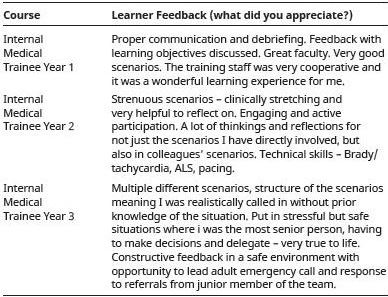
The Trust felt that a targeted programme was needed to help further prepare Internal Medical Trainees’ (IMT) for their current duties and forthcoming roles as registrars. We wanted to provide them with the opportunity to boost their confidence and practice working alongside junior medical colleagues, in order to enhance patient safety [1]. These programmes could also work alongside the regional THRIVE and STRIVE sessions.
A three-year programme was introduced. For IMT year 1, it is a half-day of 3 scenarios following a patient’s journey through an admission with key objectives being around difficult decision-making and communication. For IMT year 2, this includes a day of 5 challenging scenarios based around situations the IMT’s are called for. They look at non-technical aspects of their job in the context of complex clinical situations including bradycardia, supraventricular tachycardia, cardiac arrests, mental capacity, and duty of candour. IMT year 3, includes two days with the IMT3A course involving trainees working with Foundation Year Doctors over 5 scenarios where they are escalated to as the senior on call. The focus is developing skills such as prioritisation, leadership and communication. All candidates take part in the debriefing. The IMT3B course is a day of 5 extremely challenging scenarios in difficult settings such as out of hours or with limited senior presence. These scenarios are devised to push the IMT3 candidates in order to help prepare them for working under pressure. Scenarios include difficult ethical decision-making, litigation issues, and complex patients (e.g. pregnancy).
The sessions were positively evaluated by the IMT who expressed how they will help change their practice and enhance patient safety (see Table 1). All aspects of the course are devised to help and progress with the trainee introducing best practice and quality assurance. Debriefings are effective with discussions between peers being both positive as well as informative. We have kept class sizes to 6 participants as we have found this gives the right amount of support without being too overwhelming.

 |
We feel that as the IMT work through the programme prepares them for what is a difficult transition. Over their IMT simulation training they will take part in 18 scenarios either as a candidate or in the debriefing. It has given the IMT the chance to have high quality training in a high-fidelity environment thus promoting enhanced care and patient safety.
1. Wayne D, Didwania A, Feinglass J, Fudala M, Barsuk J,McGaghie W. Simulation-based education improves quality of care during cardiac arrest team responses at an academic teaching hospital: A case controlled study. Chest. 2008;133(1):6–9.